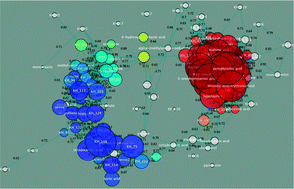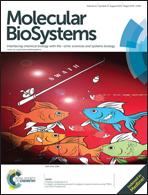Exploring the mode of action of dithranol therapy for psoriasis: a metabolomic analysis using HaCaT cells†
Abstract
Psoriasis is a common, immune-mediated inflammatory skin disease characterized by red, heavily scaled plaques. The disease affects over one million people in the UK and causes significant physical, psychological and societal impact. There is limited understanding regarding the exact pathogenesis of the disease although it is believed to be a consequence of genetic predisposition and environmental triggers. Treatments vary from topical therapies, such as dithranol, for disease of limited extent (<5% body surface area) to the new immune-targeted biologic therapies for severe psoriasis. Dithranol (also known as anthralin) is a topical therapy for psoriasis believed to work by inhibiting keratinocyte proliferation. To date there have been no metabolomic-based investigations into psoriasis. The HaCaT cell line is a model system for the epidermal keratinocyte proliferation characteristic of psoriasis and was thus chosen for study. Dithranol was applied at therapeutically relevant doses to HaCaT cells. Following the optimisation of enzyme inactivation and metabolite extraction, gas chromatography-mass spectrometry was employed for metabolomics as this addresses central metabolism. Cells were challenged with 0–0.5 μg mL−1 in 0.1 μg mL−1 steps and this quantitative perturbation generated data that were highly amenable to correlation analysis. Thus, we used a combination of traditional principal components analysis, hierarchical cluster analysis, along with correlation networks. All methods highlighted distinct metabolite groups, which had different metabolite trajectories with respect to drug concentration and the interpretation of these data established that cellular metabolism had been altered significantly and provided further clarification of the proposed mechanism of action of the drug.


 Please wait while we load your content...
Please wait while we load your content...